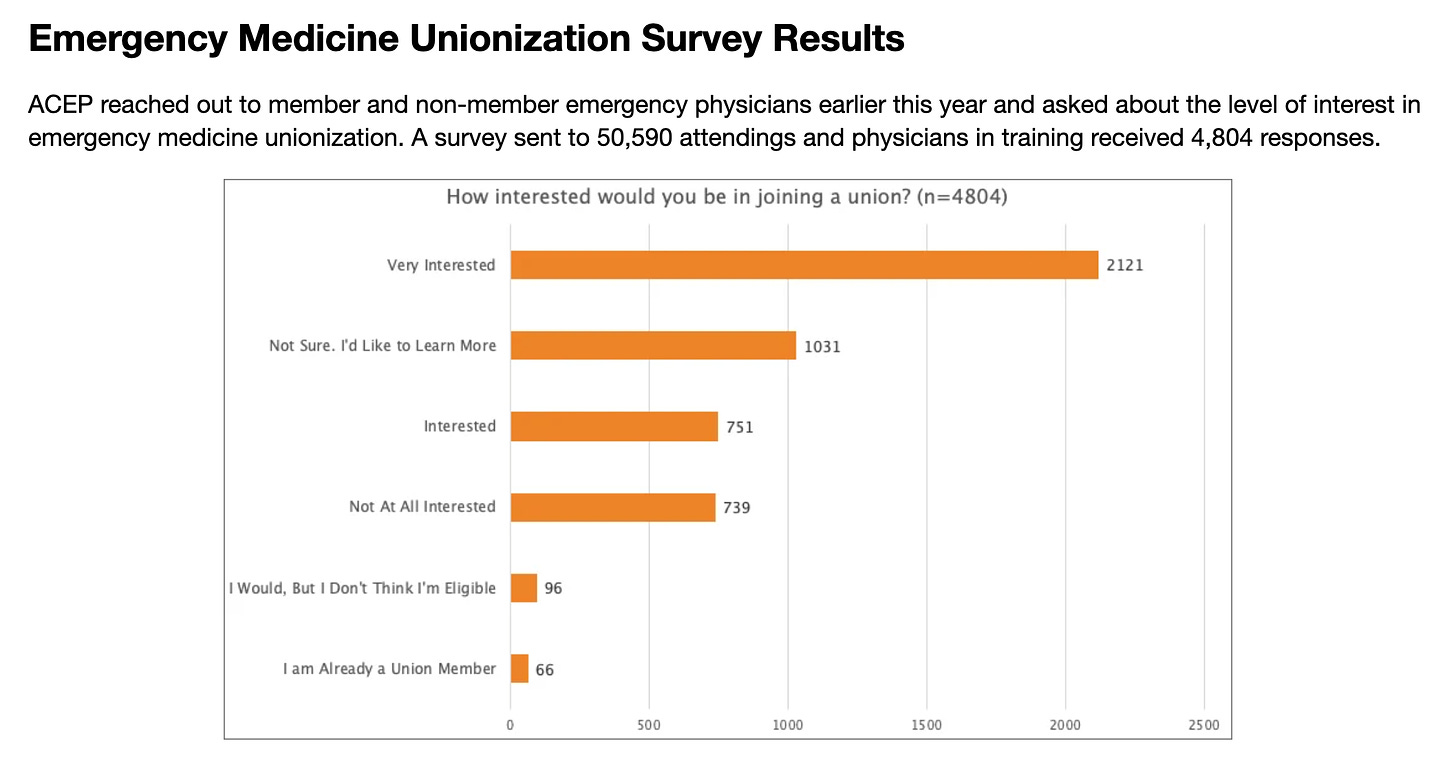Emergency Physician Unions & What They Want
ACEP recently released two important documents for employed emergency clinicians: 1) "Unionization" and 2) "Well Workplace".
The American College of Emergency Physicians has published an information paper about unionization in emergency medicine. From the report’s executive summary:
“The emergency medicine work environment is facing unprecedented challenges: escalating boarding issues, lack of resources, ever-dwindling reimbursement, sub-optimal staffing, due process infringements, loss of physician autonomy, and employment instability. Unionization is increasingly being discussed as a potential solution to some of these problems. While resident physicians have an established history of unionizing, attending physicians outside of publicly funded “county” hospitals and the Veterans Health Administration do not. ACEP member surveys show that interest is currently high; of the 4804 ACEP members who responded to a January/February internal survey, 2872 (59.8%) are very interested or interested in joining a union and an additional 1031 (21.5%) are not sure, but interested in learning more. Importantly, there is also member opposition to unionization. The question before us is to examine the viability of attending physician unionization in emergency medicine (EM).”
Click here to read the full “Unionization” document (pdf).
The paper about physician unions is appropriately paired with ACEP’s new Well Workplace Policy. This policy addresses what a group of emergency physicians would seek to negotiate regarding their working conditions.
A key introductory sentence from the policy: “Although the individual has responsibility for personal wellness, the primary emphasis should be on how the organization impacts the wellbeing of healthcare workers.”
Well Workplace
Originally approved April 2024
The American College of Emergency Physicians (ACEP) believes in the wellbeing of all those who work in healthcare and are supportive of efforts that result in a Well Workplace. A Well Workplace is prioritized by organizational leaders and personnel working together to promote, build, and sustain personal and professional health and wellbeing. The focus of a Well Workplace should be included in the departmental mission statement.
Depending on location (academic medical center, community program, urban, suburban, rural, or critical access), ACEP recognizes that a Well Workplace has different appearances. Regardless of the setting, it is incumbent upon individual organizations to cultivate wellness, keeping it at the forefront of every decision and initiative.
Although the individual has responsibility for personal wellness, the primary emphasis should be on how the organization impacts the wellbeing of healthcare workers.1 This includes, however is not limited to, fully sponsored initiatives directed at:
Organizational Influences
Provision of adequate site resources to meet patient needs at all times.2,3,4
Attention to facilities, addressing essentials such as lactation rooms,5 break rooms,6 and charting space.3
Intentional policies addressing workplace safety and violence prevention for patients, families, and healthcare workers.3
Leadership strategies to enhance physician engagement, satisfaction, and retention.7
Fully transparent sick call, paid time off/vacation, bereavement, substantial family, parental and medical leave,8 and elder care policies consistent with state legislation.9
Supportive environment with adequate mental health early recognition strategies to identify moral distress, physician impairment, mental health issues, and physician suicidality. These may include peer to peer10 and/or employee assistance programs.11
Provide training in and address in real-time:
Critical Incident Stress Management, Post-Traumatic Stress Disorder, adverse events, challenging cases.12
Mitigation of Compassion Fatigue, Second Victim Syndrome.13
Practice Environment Influences
Full staffing of all workers in the department required for patient care, including ancillary staff and non-departmental employees such as transportation, environmental services, laboratory, radiological services, and security.3,4,14
Directed critical efforts with institutional leadership at the highest level to measure, report, and solve boarding15 and overcrowding burden.16
Establishing physician-led on-site teams to adequately supervise non-physician providers if provided.17,18
Prioritization of Diversity, Equity, and Inclusion for all.19-21
Attention to improving operational flow through human factors engineering.3,22
Best possible employee nutritional options available 24/7.6
Burden reduction of administrative tasks: Focused electronic medical record23 systems optimization, with paid on-line training and paid off-shift chart completion.24,25
Reduction of non-essential communications, meetings, and email.26
Culture
Anonymous, comprehensive, and objective evaluation of wellness outcomes and departmental leadership by staff to ensure accountability to address, maintain, and improve workplace wellness.27
Transparent and equitable compensation, promotion, due process policies and clearly defined reasonable and sustainable productivity metrics.28
Establishment of effective departmental/hospital wellness committees.
Culture of teamwork, with expectation and enforcement of interdisciplinary respect, empathy, and collegiality.
Support programs that include, but are not limited to addressing:
Recognition of the relevance of aging physicians in the workplace; retirement planning.29
Litigation stressors.30
Financial issues.31
Mentoring and/or coaching.19,20,21
Individualized schedule optimization.32
References
Manfredi R, Krywko D. From Self to System: Being Well in Emergency Medicine. ACEP Wellness Guidebook. 2024.
Model of Clinical Practice of Emergency Medicine. ACEP Web site. Published June 2023. Accessed March 1, 2024.
Safer Working Conditions for Emergency Department Staff. ACEP Web site. Published April 2021. Accessed March 1, 2024.
Emergency Department Planning and Resource Guides. ACEP Web site. Originally published December 1985. Updated and approved April 2021. Accessed March 1, 2024.
Support for Nursing Mothers. ACEP Web site. Originally published February 2020. Updated and approved October 2013. Accessed March 1, 2024.
Food and Drink for Staff in the Emergency Department. ACEP Web site. Published April 2020. Accessed March 1, 2024.
Kase J, Doolittle B. Job and life satisfaction among emergency physicians: a qualitative study. PLoSOne. 2023;1892):e0279425.
Family and Medical Leave. ACEP Web site. Originally published June 1990. Updated and approved August 2022. Accessed March 1, 2024.
Assignment of Benefits. ACEP Web site. Originally published April 2006. Updated and approved January 2024. Accessed March 1, 2024.
Physician Wellness Hub. Peer to Peer. ACEP Web site. Published June 2020. Accessed March 1, 2024.
R. 1667 - Dr. Lorna Breen Health Care Provider Protection Act. Congress.gov Web site. Published March 18, 2022. Accessed March 1, 2024.
Disclosure of Medical Errors. ACEP Web site. Originally published September 2003. Updated and approved March 2023. Accessed March 1, 2024.
Physician Wellness Hub. Compassion Fatigue. ACEP Web site. Accessed March 1, 2024.
Emergency Department Nurse Staffing. ACEP Web site. Originally published June 1999. Updated and approved April 2022. Accessed March 1, 2024.
Boarding of Admitted and Intensive Care Patients in the Emergency Department. ACEP Web site. Originally published October 2000. Updated and approved February 2023. Accessed March 1, 2024.
Crowding. ACEP Web site. Originally published January 2006. Updated and approved April 2019. Accessed March 1, 2024.
State Board of Medicine Regulation of Non-Physician Practitioners Practicing Medicine. ACEP Web site. Published April 2023. Accessed March 1, 2024.
Guidelines Regarding the Role of Physician Assistants and Nurse Practitioners in the Emergency Department. ACEP Web site. Published June 2023. Accessed March 1, 2024.
Workforce Diversity in Health Care Settings. ACEP Web site. Originally published October 2001. Updated and approved June 2023. Accessed March 1, 2024.
Maximizing the Potential of Women in Emergency Medicine Women in Medicine. ACEP Web site. Originally published October 2014. Updated and approved February 2020. Accessed March 1, 2024.
Overcoming Barriers to Promotion of Women and Underrepresented in Medicine (URiM) Faculty in Academic Emergency Medicine. ACEP Web site. Published October 2020. Accessed March 1, 2024.
Wears R, Perry S. Human factors and ergonomics in the emergency department. Ann Emerg Med. 2022 Aug;40(2):206-12. doi: https://doi.org/10.1067/mem.2002.124900
Patient Medical Records in the Emergency Department. ACEP Web site. Originally published January 1997. Updated and approved June 2022. Accessed March 1, 2024.
CME Burden. ACEP Web site. Originally published April 2016. Updated and approved January 2022. Accessed March 1, 2024.
Compensated Time for Faculty Academic Administration and Teaching Involvement. ACEP Web site. Published June 2019. Accessed March 1, 2024.
Health Information Technology for Emergency Care. ACEP Web site. Originally published October 1998. Updated and approved April 2021. Accessed March 1, 2024.
FSMB Policy on Physician Wellness and Burnout. Federation of State Medical Boards Web site. Published April 2018. Accessed March 1, 2024.
Compensation Arrangements for Emergency Physicians. ACEP Web site. Originally published 1988. Updated and approved April 2021. Accessed March 1, 2024.
Considerations for Emergency Physicians in Pre-Retirement Years. ACEP Web site. Originally published June 2009. Reaffirmed January 2021. Accessed March 1, 2024.
Protection of Physicians and Other Health Care Professionals from Criminal Liability for Medical Care Provided. ACEP Web site. Published June 2022. Accessed March 1, 2024.
Medical Practice Review and the Practice of Medicine. ACEP Web site. Originally published May 2018. Updated and approved January 2024. Accessed March 1, 2024.
Emergency Physician Shift Work. ACEP Web site. Originally published September 1994. Updated and approved September 2003. Accessed March 1, 2024.
Emergency Medicine Workforce Productions is sponsored by Ivy Clinicians - simplifying the emergency medicine job search through transparency.







I knew this was coming and have been an advocate of EMP’s unionization for years. It’s too bad that my career was ruined due to lack of due process under “without cause” locums contracts. Unionization will be protection for all the young graduating residents and the years of sacrifice they’ve endured.